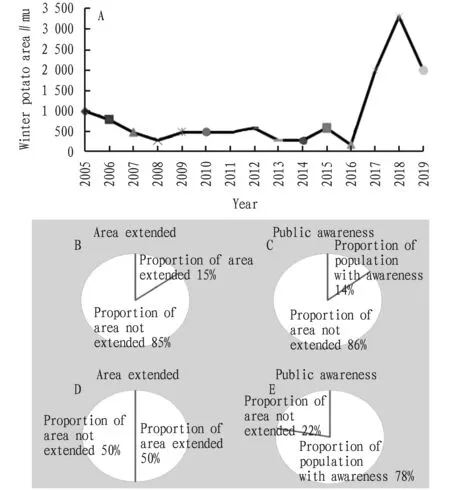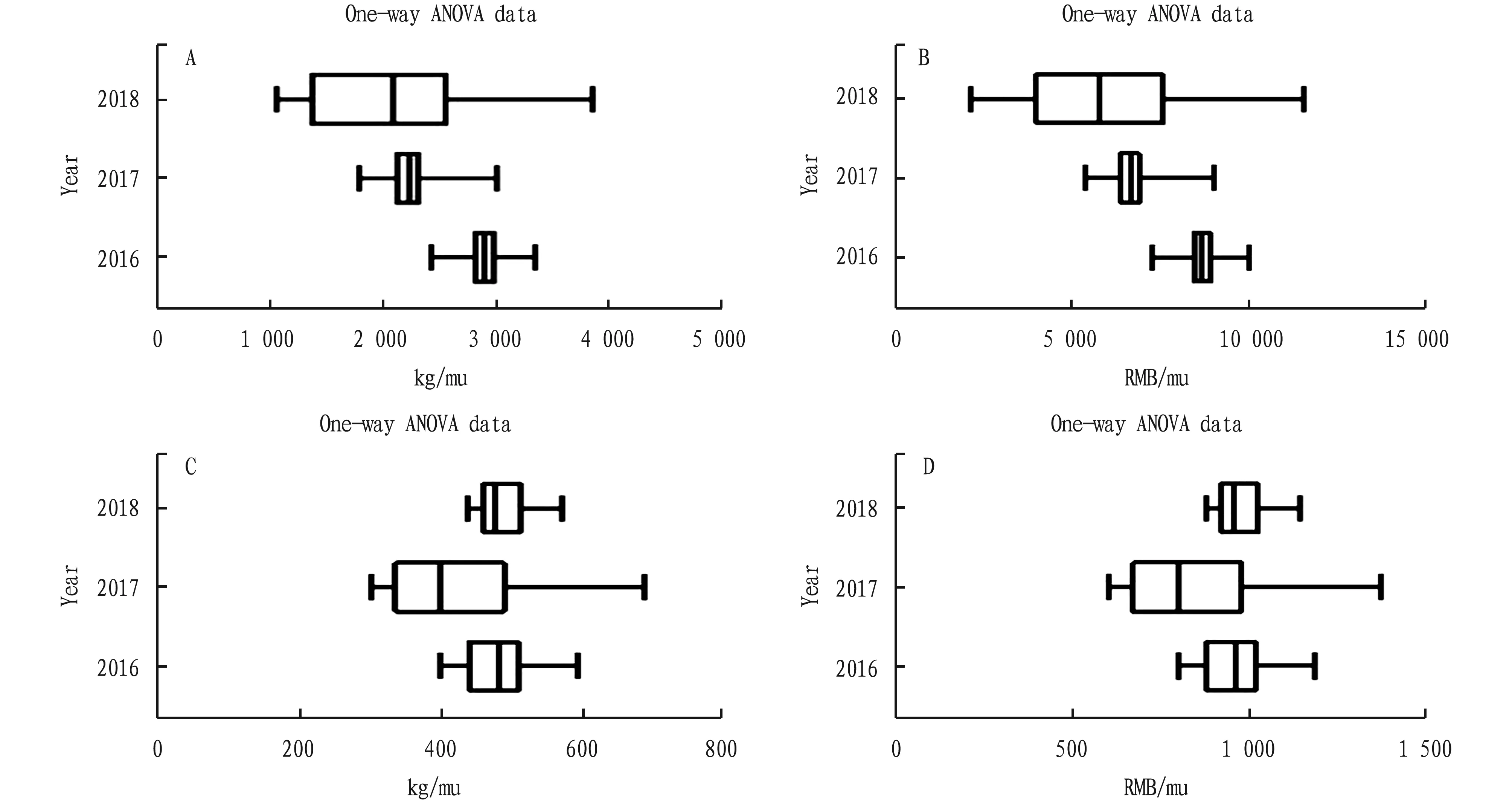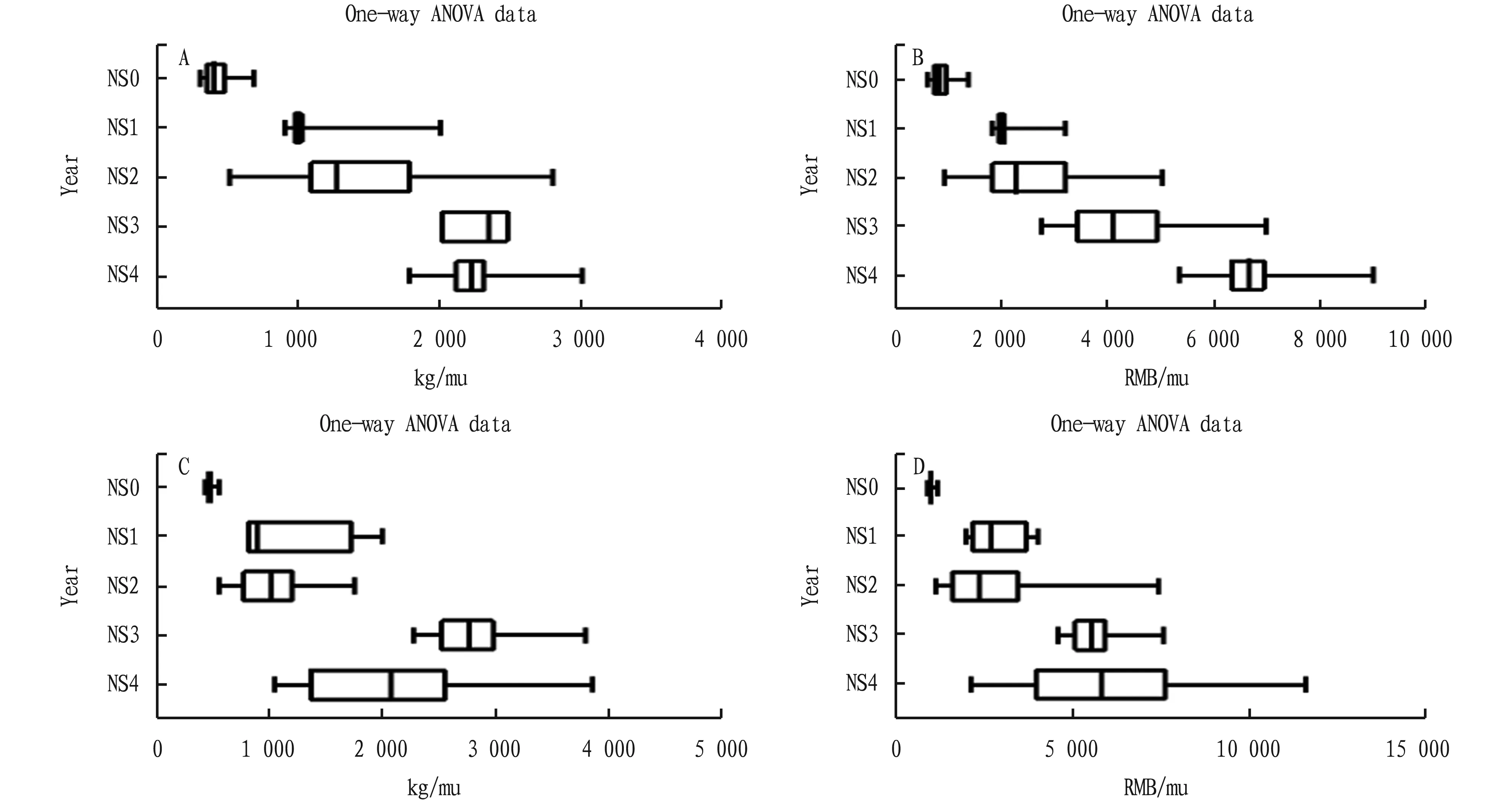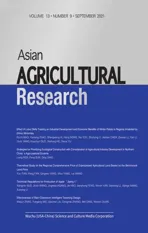Effect of Labor Skills Training on Industrial Development and Economic Benefits of Winter Potato in Regions Inhabited by Ethnic Minorities: A Case Study of Lancang Lahu Autonomous County
2021-12-01RuzhiMAOYanlongZHAOShengxiangAIHongSONGXiaYOUShuhongLIJianbinCHENZuosenLIYanLIYanliYANGHuachunGUOXiahongHEDecaiYU
Ruzhi MAO, Yanlong ZHAO, Shengxiang AI, Hong SONG, Xia YOU, Shuhong LI, Jianbin CHEN, Zuosen LI, Yan LI, Yanli YANG, Huachun GUO, Xiahong HE, Decai YU*
1. Yunnan Agricultural University, Kunming 650201, China; 2. Southwest Forestry University, Kunming 650224, China; 3. Lancang Vocational High School, Lancang 665600, China; 4. Lancang Agricultural Technology Extension Center, Lancang 665600, China
Abstract Using three kinds of labor skills training methods (expert team training, recruit training and local agricultural extension center training), based on enterprise planting and farmer planting, this paper analyzes the impact of training methods on the development of potato industry, such as yield, income and planting extension. The results show that the expert team training, recruit training and labor skills training of local agricultural extension center can significantly improve the labor quality and skills, and increase the yield and income of winter potatoes. The expert team training, recruit training and local agricultural extension center training can lift growers out of poverty and improve the willingness of people to plant and extend. The winter potato industry has become one of the pillar industries to shake off poverty and become rich, increasing local economic benefits. Through labor skills training, the winter potato industry has become one of the main industries to improve the quality of the local people and increase economic income, promoting the local people to shake off poverty and become well-off.
Key words Winter potato, Labor skills training, Promoting industrial development, Increasing economic benefits
1 Introduction
Potato has become the fourth largest food crop in China. China’s winter potato industry originated in the south, such as Guangxi, Guangdong, Hainan, and Yunnan. Yunnan is one of the earliest regions to plant winter potato, and it has unique climatic advantages. Yunnan is the largest winter potato producing area in China, with a planting area of about 200 000 ha. After 10 years of winter potato cultivation practice, the team of Yunnan Agricultural University has established a potato technology extension system at the provincial, city, county and township levels, and winter potato industry is the plateau characteristic agriculture in Yunnan Province. The area and yield of winter potato in Yunnan Province are close to 10% of the province’s potato planting area and yield, and the development of winter potato has unique geographical, climatic and market advantages. Good economic benefits have been achieved in some suitable areas of Yunnan Province, such as Honghe, Dehong, Lincang and Pu’er. For example, winter fallow fields are turned to effective fields and making use of ecological conditions such as less rainfall, strong light and large temperature difference between day and night in tropical river valleys can effectively inhibit diseases and pests, reduce the amount of pesticides by 60%, and greatly improve the yield and quality of potatoes. Potato industry is one of the most direct industries for short-term poverty alleviation in Yunnan hot areas because of its short growth cycle, high yield and high income. Winter potato cultivation technology is the most feasible to spread as a mature science and technology in Yunnan hot areas. At present, there is still a lot of room for the development of winter potato in Yunnan border areas.
At present, there are many kinds of labor skills training based on agricultural science and technology modes at home and abroad. Wang Qian analyzed the supply of kiwifruit agricultural industry science and technology training and farmers’ demand will in Shaanxi Province, and proposed measures and methods to improve the efficiency of agricultural technology extension and training, to increase farmers’ income and to enhance sustainable development in agriculture and rural areas. Yan Jiet
al.
carried out policy analysis on the strategy of promoting poverty alleviation through labor skills in agricultural science and technology. Xu Jinhaiet
al.
studied the demand of farmers for labor skills training based on agricultural science and technology service. Si Xueganget
al.
analyzed the impact of labor skills training based on agricultural science and technology on the development of modern agriculture. Dilinuer Abula explored the factors of the transformation of labor skills related to agricultural science and technology. Ding Linhuiet
al.
studied the measures of labor skills training under the new normal of economy. Song Huaminget
al.
studied the development of modern agriculture and the training methods of skilled talents in agricultural science and technology.Liang Xian analyzed and thought about the demand of labor skills training in agricultural science and technology at the present stage. However, there are few reports on the training of agricultural science and technology labor skills in the rural agricultural industry in the border areas. At present, the industry in the regions inhabited by ethnic minorities of Yunnan is weak, small and scattered, so there is an urgent need to develop crops with high economic benefits, short production cycle, easy growth and management methods, and mature cultivation technology as a new industry. After years of observation in many areas, the potato production cycle is four months, and the benefit per 667 mis as high as 6 000-10 000 yuan. It has a mature technical system and promotion system, and is the first choice industry to drive the poor people out of poverty and become rich.In the areas with low degree of social development, underdeveloped commodity economy, outdated ideas and lack of awareness of market competition, the masses lack the necessary labor skills to develop the industry. Through labor skills training, it is of great significance to enable ethnic minorities to master winter potato cultivation techniques, promote the development of winter potato industry, and help people get rid of poverty and become rich.
2 Areas and methods of labor skills training based on agricultural science and technology for winter potatoes
2.1 Basic information of the training area
For example, Lancang Lahu Autonomous County, located in the southwest of Yunnan Province, is the largest Lahu settlement, where the incidence of poverty is 34.56%, the number of poor people ranks fourth in Yunnan Province and the first in Pu’er City. Poverty is caused by low labor quality and lack of labor skills. The period from October to June of the following year in Lancang Lahu Autonomous County is the dry season, the number of sunshine hours is about 1 800, and the average temperature is 13.6-19.5 ℃. About 60% of the area is fallow in winter, with an elevation of 800-1 600 m above sea level. The soil is mostly sandy loam with loose texture, good permeability and high content of organic matter. The area of valley plains such as Shangyunba, Menglangba, Mengbinba, Xiayunba, Huigeba and Xiyunba is about 13 300 ha, which is very suitable for the development of winter potatoes.2.2 Training methods
2.2.1
NS4 level. The potato expert team of Yunnan Agricultural University provides training on the spot about potato planting techniques, potato field plot selection standards, field soil preparation methods, potato seed breeding process, storage and seed cutting methods, field planting specifications and methods, use of small agricultural machinery and tools, high-yield potato cultivation technical regulations and management, identification of main diseases and symptoms, field water and fertilizer management and integrated control techniques.2.2.2
NS3 level. Lancang Vocational High School is responsible for recruiting local farmers aged 18-60 in Lancang County. The potato teacher team of Yunnan Agricultural University compiles teaching materials for training trainees, adopts practical training system, and teaches potato planting techniques directly, including potato field plot selection standards, field soil preparation methods, potato seed breeding process, storage and seed cutting methods, field planting specifications and methods, use of small agricultural machinery and tools, high-yield potato cultivation technical regulations and management, identification of main diseases and symptoms, field water and fertilizer management and integrated control techniques. Each student receives potato seeds (667 m), chemical fertilizers and pesticides, and personally plants potato in the field, and the teachers go to the trainees’ land regularly to guide the management of water, fertilizer, diseases and pests. Taking the yield as the standard, the evaluation standard was established.2.2.3
NS2 level. The training from local agricultural extension center is the training from the county level agricultural extension center and the township level agricultural service center for farmers to plant.2.2.4
NS1 level. Planting enterprises grow their own plants and carry out simple training.2.2.5
NS0 level. The scattered farmers receive no training.2.3 Data collection methods
Statistics of winter potato planting from 2005 to 2019 from the Agricultural Extension Center of Lancang Lahu Autonomous County are collected. We conduct a survey of the area, yield and income of trainees (Lahu, Hani, Wa, Yi and Dai nationalities), enterprises and farmers in the whole county in 2016, 2017 and 2018, as well as the planting willingness and extension willingness in suitable areas.2.4 Data analysis methods
Microsoft office 2013 is used for data collation and analysis, and Graphpad 7.0 software is used for data collation,T
-test and one-way ANOVE analysis.3 Results and analysis
3.1 Development and public awareness of winter potato industry in Lancang Lahu Autonomous County during 2005-2019
Fig.1 shows that the planting area of winter potato during 2005-2019 was extremely unstable and made no progress in 10 years, with an area below 66.67 ha, a low in 2016, a peak in 2018 (reaching 220 ha), and a planned area extended of 133.33 ha in 2019 (Fig.1A). According to the survey and statistical analysis of the planting area, it is found that only 15% of the towns were the extension areas before 2016 (Fig.1B), and the public awareness was 14% (Fig.1C). The winter potato industry is a small industry in local areas.50% of the towns became the extension areas after 2016-2018 (Fig.1D), the public awareness was increased to 79% (Fig.1E), and the winter potato has become one of the major local industries.
Note: 1 mu=667 m2 in the picture.
3.2 Effect of winter potato training on yield and income of winter potato
From the perspective of different years of winter potato training, the on-the-spot training effect of potato expert team of Yunnan Agricultural University is the best. After the training for the masses in 2016, 2017 and 2018, the average annual yield (Fig.2A) and income (Fig.2B) decreased year by year, and tended to be stable in 2017 and 2018. The average annual income exceeded the poverty alleviation standard of 56 250 yuan/ha, and 1-2 people can be lifted out of poverty every 667 mof winter potatoes(Table 1).The potato expert team of Yunnan Agricultural University is responsible for training, the yield and income of the trainees in 2018 were significantly higher than those in 2017 (Table 2 and Table 3). The yield increased by 518 kg/667 mand the income increased by 1 315 yuan/667 m. One person can be lifted out of poverty per 667 mof winter potato. Compared with 2017, the way of training for farmers by the local agricultural extension center in 2018 made the yield of farmers decrease significantly and the income decrease (Table 2 and Table 3), but there was no significant difference, the planting area was expanded, the guidance was insufficient, and the effect decreased.Enterprise planting model: compared with 2017, the yield decreased by 100 kg/667 mand the income increased by 467 yuan/667 min 2018 (Table 2 and Table 3), but the difference was not significant, which indicated that cultivation and management techniques had not been improved.
Scattered farmer planting model: the average annual yield and income of growers without training tended to be stable in 2016, 2017 and 2018, and the average yield per 667 mwas 484.4, 416.2, 484.9 kg (Fig.2C), respectively, and the average income was 968.7, 832.4, 969.8 yuan/667 m(Fig.2D). The yield is low, the income is low, the benefit is the worst, so it is not worth extension.

Fig.2 Effect of yield and income per 667 m2 of winter potato industry in different years
According to the different training modes of winter potato planting, the on-the-spot training of potato expert team of Yunnan Agricultural University in 2016, 2017 and 2018 was very effective, and the yield of farmers who received the training increased in 2016 (2 902 kg/667 mvs. 484.4 kg/667 m), 2017 (2 266 kg/667 mvs. 416.2 kg/667 m) and 2018 (2 075 kg/667 mvs. 484.9 kg/667 m), and the income increased in 2016 (8 705 yuan/667 mvs. 968.7 yuan/667 m), 2017 (6 797 yuan/667 mvs. 832.4 yuan/667 m) and 2018 (5 951 yuan/667 mvs. 969.8 yuan/667 m) (Table 2 and Table 3). In 2017, the yield differences between all models were extremely significant (2 266, 2 271, 1 406, 1 300, 416.2 kg/667 m, respectively) (Fig.3A), and the income differences were extremely significant (6 797, 5 579, 2 506, 2 333, 832.4 yuan/667 m, respectively) (Fig.3B). In 2018, the yield differences between all models were extremely significant (2 075, 2 789, 1 042, 1 200, 484.9 kg, respectively) (Fig.3C), and the income differences were extremely significant (5 951, 5 579, 2 396, 2 800, 969.8 yuan/667 m) (Fig.3D).

Table 1 Effect of labor skills training based on agricultural science and technology on the yield of winter potatoes from 2016 to 2019

Table 2 Effect of labor skills training based on agricultural science and technology on the income of winter potatoes from 2016 to 2019

Table 3 Willingness of trainees to plant and promote winter potatoes after labor skills training

Fig.3 Effect of labor skills training based on agricultural science and technology on yield and income per 667 m2 of winter potato industry
Based on the analysis of the yield and income for the same planting pattern in different years or different training models in the same year, the on-the-spot training model of the potato expert team of Yunnan Agricultural University is better than the student training model of the potato expert team of Yunnan Agricultural University; the student training model of the potato expert team of Yunnan Agricultural University is better than the farmer training model of local agricultural extension centers; the farmer training model of local agricultural extension centers is better than the enterprise planting model; the enterprise planting model is better than the farmer planting model.
3.3 Effect of labor skills training on trainees’ willingness to plant and promote winter potatoes
The survey and analysis show that in the frost-free area at an altitude of 900-1 300 m, the average area of winter potatoes that people are willing to plant is 0.547 8 ha per person (the smallest of 667 m, the highest of 1.33 ha), and the average area of winter potatoes that people are willing to promote is 9.446 7 ha per person (the smallest of 1.33 ha, the highest of 33.33 ha). In the light-frost area at 1 300-1 500 m above sea level, the average area of winter potatoes that people are willing to plant is 0.698 7 ha per person (the smallest of 0.133 ha, the highest of 1.33 ha), and the average area of winter potatoes that people are willing to promote is 20.133 ha per person (the smallest of 1.33 ha, the highest of 133.33 ha). Generally, the planting willingness and promotion enthusiasm of winter potato are high, and the enthusiasm in the light-frost region at 1 300-1 500 m above sea level is higher than that in the frost-free region at 1 300 m above sea level, which is of positive significance to promoting the expansion and development of winter potato industry.4 Discussion
The labor skills training based on agricultural science and technology is the main method and force to promote the new industry at present. According to the survey and analysis, it is concluded that the labor skills training based on agricultural science and technology in the vast rural areas has a relatively positive impact on the improvement of agricultural productivity. Improving the quality of rural laborers is an important way to promote agricultural development and increase farmers’ income, and also an important way to drive innovative development strategy.We carried out a survey in conjunction with Yunnan Agricultural University, Lancang Vocational High School and Lancang Agricultural Technology Extension Center in Lancang County, a frontier minority region of Yunnan Province. In Lancang County, the average education length is 6.3 years, it has inconvenient transportation and information is deficient, lacking understanding of labor skills based on agricultural science and technology. There was no poverty alleviation-oriented promotion of winter potato industry, and the public awareness of winter potato industry was poor in Lancang County before 2016. In order to promote winter potato planting in this region, labor skills training is very important. Through the publicity and practical guidance for trainees and the masses, farmers’ recognition of winter potato industry increased from 2016 to 2019, and winter potato has become one of the main local industries.
After the trainees and the masses took part in the labor skills training, the yield and income of winter potatoes were greatly increased, which is consistent with the survey results of P. Agres, but different from the results of P. Agres, the training effect is affected by annual climate, sowing date, management and planting area. The most obvious is that the agricultural extension center’s guidance area is large, there is a lack of guidance, resulting in annual yield fluctuations, production decline and income decline phenomenon. The expert team’s one-to-one guidance is also faced with the same situation. From the perspective of training methods, after taking part in the training, the trainees and the masses have mastered the techniques of planting winter potatoes, and the yield and income have been improved. The annual income of winter potatoes per 667 mfor the trainees and the masses have a high degree of mastery is nearly 10 000 yuan, and 1-2 people can be lifted out of poverty (estimated by the poverty alleviation line of 3 750 yuan). This is a bright spot and novel result of the survey, and there are no researchers involved in this area at present. The results of the survey on the trainees in the area suitable for winter potato are similar to those of Xu Jinhai. In this case, each trainee can grow 0.533-0.667 ha of winter potato and extend 9.400-20.667 ha of winter potato. The social benefit is excellent and the training effect is good. The winter potato can be used as an agricultural industry for local poor people to shake off poverty and go to a well-off society for a long time. This labor skills training model has important reference value and reference significance for promoting the poor people in China’s border areas to shake off poverty and move towards a well-off society.
杂志排行
Asian Agricultural Research的其它文章
- Effectiveness of Rain Classroom Intelligent Teaching Design: A Case Study of the Course of Spring Water Tourism Resources
- Investigation of Cultivated Woody Plant Resources in Ping’an District of Qinghai Province in China
- Technical Regulations for Production of Apple ‘Jiping 1’
- Strategies for Prioritizing Ecological Construction with Consideration of Agricultural Industry Development in Northern China’s Agro-pastoral Ecotone: A Perspective of Opportunity Cost
- Development of Rural Tourism in Liaoning Province from the Perspective of Types
- Theoretical Study on the Regional Comprehensive Price of Expropriated Agricultural Land Based on the Benchmark Land Price
